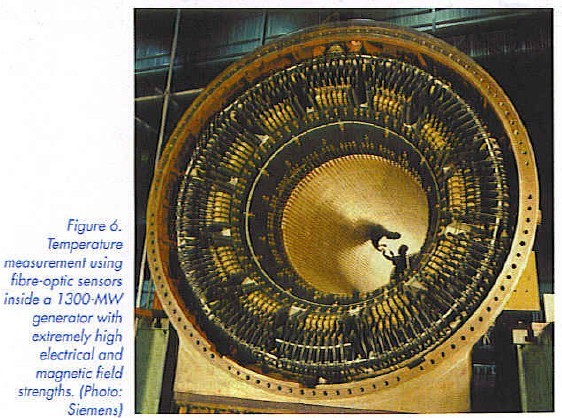

Project Solutions
Sensors Go Systematic (5)
Published:2011/7/28 5:25:00 Author:Amy From:SeekIC
By Helmuth Lemme
However, it is also possible to use die actual fibre as the measuring element. Such "intrinsic” fibre-optic systems exploit the miniscule but still present effects of external physical quantities on the propagation of light through the fibre. If the wave nature of the light is also taken into account, very high sensitivity and resolution can be achieved. A widely used technique involves writing a ’Bragg grating’ into the fibre. A Bragg grating is a periodic series of regions having an elevated refractive index, which is generated by means of UV irradiation. Light with a wavelength that exactly corresponds to twice the grating spacing is reflected back to the optical source, while all other wavelengths pass through unaffected. If the fibre is stretched, light with a somewhat longer wavelength will be reflected, and this can be measured optically. This yields a highly sensitive elongation sensor that operates without electricity, cannot be affected by extremely strong ambient electromagnetic fields, and cannot itself interfere with anything else.
There are very many physical effects that can influence the propagation of light in a fibre. Quantities that can be measured in this manner include elongation, tensile stress, vibration, flow, filling level, pressure, angle of rotation, temperature, ionizing radiation and many others. This makes it possible to make a wide variety of measurements under difficult conditions, in situations where such measurements were previously considered to be out of the question - such as deep inside the 1300-MW generator shown in Figure 6. 
Passive RF sensors
With rapidly rotating machine parts, a sensor link via commutator rings is frequently not sufficiently reliable. In such situations, it is possible to use another sensor technology that does not require a local power source: surface acoustic wave chips. These components, which are made from piezoelectric crystals (such as lithium niobate), are used as bandpass filters in radio receivers. An RF alternating voltage applied to the input comb electrodes (typically with a frequency of several hundred megahertz to a few gigahertz) generates a shallow mechanical wave on the surface of the crystal. This wave propagates over the length of the crystal until it is reflected at the other end and returns back to the electrodes, where it again generates an alternating voltage that is slightly delayed from the excitation pulse. If a sensor (for example, a capacitive pressure sensor) is connected to a second set of electrodes at the far end of the crystal, the reflection of the waves will be affected by the sensor in a manner that depends on the pressure. The pressure can then be determined by evaluating the returned signal (Figure 7). If an aerial is connected to the input, the sensor can be queried using radio waves. This technology has been studied in the research departments of tyre manufacturers as a means of acquiring measurement data from rotating tyres (pressure, temperature and traction) without using a battery as a power source. For more on this subject, see the article "Wireless tyre-pressure monitoring’ elsewhere in this issue.

Reprinted Url Of This Article: http://www.seekic.com/blog/project_solutions/2011/07/28/Sensors_Go_Systematic_(5).html
Print this Page | Comments | Reading(333)
Article Categories
New published articles
· Imagination works with TSMC to develop FinFET process
Author:Ecco Reading(33527)
· XMOS pushes event-driven MCUs with lower price
Author:Ecco Reading(3534)
· Intel brings upgraded 32-nm SoC for smartphones
Author:Ecco Reading(3250)
· Micron pushes TLC 128-Gbit NAND flash
Author:Ecco Reading(3816)
· Intel will stop supplying desktop motherboards
Author:Ecco Reading(5341)
· Processor market was expected to regain strength in 2013
Author:Ecco Reading(3318)
· It was reported that TSMC sales fall steeply
Author:Ecco Reading(3474)
· Cisco, NXP work with auto wireless startup
Author:Ecco Reading(3620)
· Micron was impacted by manufacturing glitch
Author:Ecco Reading(4017)
· China can make 22-nm transistor by themselves
Author:Ecco Reading(3820)
· Chip market rebound is coming, according to survey
Author:Ecco Reading(3761)
· Sony, Toshiba will spend more on chips, iSuppli reports
Author:Ecco Reading(3790)
· Qualcomm becomes the 13th company to join NFC Forum board
Author:Ecco Reading(6105)
· TSMC increases building work for FinFET fab
Author:Ecco Reading(3778)
· TI plans to cut 1,700 jobs in OMAP shift
Author:Ecco Reading(4587)